Genesis of Caoziwa Pb–Zn Deposit in Tengchong Block, SW China: Constraints from Sulfur Isotopic and Trace Elemental Compositions of Sulfides
Abstract
1. Introduction
2. Geological Setting
2.1. Regional Geology
2.2. Deposit Geology
3. Sampling and Analytical Methods
4. Analytical Results
4.1. Sulfur Isotope
4.2. Trace Elements of Sulfides
5. Discussion
5.1. Trace Element Speciation in Sulfides
5.2. Sources of Ore-Forming Materials
5.3. Genetic Type of Caoziwa Deposit
6. Conclusions
- (1).
- In the Caoziwa Pb–Zn deposit, abundant Co, Ni, As, and Se, and less Cu, Zn, Ag, Cd, Sn, Sb, Te, Pb, and Bi could enter the pyrite crystal lattice by isomorphic substitution. Elemental Mn, Fe, Cd, Co, and Ni could enter the crystal lattice of sphalerite by isomorphic substitution, while the Ag, Sn, and Sb contents are mainly controlled by the Pb-rich inclusions in sphalerite. Elemental Bi, Sb, Cd, Sn, Ag, and Tl mainly enter the galena grains by the isomorphic substitution mechanism of (Bi, Sb)3+ + (Cd, Sn)2+ + (Ag, Tl)+ ↔ 2Pb2+.
- (2).
- The ore-forming materials and fluids of the Caoziwa Pb–Zn deposit mainly originate from magmatic hydrothermal fluid.
- (3).
- The Caoziwa deposit is a magmatic hydrothermal vein-type Pb–Zn deposit that probably belongs to a distal part of a skarn mineralization system developed by the intrusion of Paleocene granitic magmatism in the western part of the Tengchong block.
Author Contributions
Funding
Data Availability Statement
Conflicts of Interest
References
- Deng, J.; Wang, Q.; Li, G.J.; Santosh, M. Cenozoic tectono-magmatic and metallogenic processes in the Sanjiang region, southwestern China. Earth-Sci. Rev. 2014, 138, 268–299. [Google Scholar] [CrossRef]
- Deng, J.; Wang, Q.F.; Li, G.J.; Li, C.S.; Wang, C.M. Tethys tectonic evolution and its bearing on the distribution of important mineral deposits in the Sanjiang region, SW China. Gondwana Res. 2014, 26, 419–437. [Google Scholar] [CrossRef]
- Chen, F.C.; Deng, J.; Shu, Q.H.; Li, G.J.; Cui, X.L.; Zhao, F.; Wang, Q.F. Geology, fluid inclusion and stable isotopes (O, S) of the Hetaoping distal skarn Zn-Pb deposit, northern Baoshan block, SW China. Ore Geol. Rev. 2017, 90, 913–927. [Google Scholar] [CrossRef]
- Chen, F.C.; Cheng, X.L.; Han, R.S.; Li, G.J.; Liu, J.Y.; Chang, H.; Jia, Z.; Cheng, Y. The fractionation of iron isotope and its constraints on the sources of ore-forming materials in the Jinchanghe skarn polymetallic deposit in Sanjiang region, Southwest China. Acta Petrol. Sin. 2022, 38, 157–171. (In Chinese) [Google Scholar]
- Cui, X.L.; Wang, Q.F.; Deng, J.; Wu, H.Y.; Shu, Q.H. Genesis of the Xiaolonghe quartz vein type Sn deposit, SW China: Insights from cathodoluminescence textures and trace elements of quartz, fluid inclusions, and oxygen isotopes. Ore Geol. Rev. 2019, 111, 102929. [Google Scholar] [CrossRef]
- Xie, J.C.; Zhu, D.C.; Dong, G.C.; Zhao, Z.D.; Wang, Q.F.; Mo, X.X. Linking the Tengchong Terrane in SW Yunnan with the Lhasa Terrane in southern Tibet through magmatic correlation. Gondwana Res. 2016, 39, 217–229. [Google Scholar] [CrossRef]
- Zhang, Q.W.; Wang, Q.F.; Li, G.J.; Sun, X.; Shu, Q.H.; Deng, J. Crucial control on magmatic-hydrothermal Sn deposit in the Tengchong block, SW China: Evidence from magma differentiation and zircon geochemistry. Geosci. Front. 2022, 13, 133–147. [Google Scholar] [CrossRef]
- Yao, Y.W.; Zhang, J.; Ma, N.; Zheng, Y.Z. Characteristics and geological significance of alteration zoning of skarn in Diantan Iron mine, Yunnan Province. Miner. Depos. 2012, 31, 143–144. (In Chinese) [Google Scholar]
- Cao, H.W.; Zhang, S.T.; Lin, J.Z.; Zheng, L.; Wu, J.D.; Li, D. Geology, geochemistry and geochronology of the Jiaojiguanliangzi Fe-polymetallic deposit, Tengchong County, Western Yunnan (China): Regional tectonic implications. J. Asian Earth Sci. 2014, 81, 142–152. [Google Scholar] [CrossRef]
- Sun, Z.R.; Dong, G.C.; Zhao, Z.X.; Wang, W.Q.; Liu, S.Q. Petrological, geochemical and geochronological features of Lailishan ganitoids in western Yunnan and their genesis of partial melting of crustal soure. Geol. China 2017, 44, 1140–1158. (In Chinese) [Google Scholar]
- Cui, X.L. Study of the Cretaceous Fe and Sn Mineralization in Tengchong–Linghe District, Sanjiang Region, Southwestern China. Ph.D. Thesis, China University of Geosciences, Beijing, China, 2019. (In Chinese). [Google Scholar]
- Chen, X.C.; Hu, R.Z.; Bi, X.W.; Li, H.M.; Lan, J.B.; Zhao, C.H.; Zhu, J.J. Cassiterite LA-MC-ICP-MS U/Pb and muscovite 40Ar/39Ar dating of tin deposits in the Tengchong-Lianghe tin district, NW Yunnan, China. Miner. Depos. 2014, 49, 843–860. [Google Scholar] [CrossRef]
- Cao, H.W.; Zhang, Y.H.; Pei, Q.M.; Zhang, R.Q.; Tang, L.; Lin, B.; Cai, G.J. U–Pb dating of zircon and cassiterite from the Early Cretaceous Jiaojiguan iron-tin polymetallic deposit, implications for magmatism and metallogeny of the Tengchong area, western Yunnan, China. Int. Geol. Rev. 2017, 59, 234–258. [Google Scholar] [CrossRef]
- Cao, H.W.; Pei, Q.M.; Zhang, S.T.; Zhang, L.K.; Tang, L.; Lin, J.Z.; Zheng, L. Geology, geochemistry and genesis of the Eocene Lailishan Sn deposit in the Sanjiang region, SW China. J. Asian Earth Sci. 2017, 137, 220–240. [Google Scholar] [CrossRef]
- Deng, J.; Wang, Q.F.; Li, G.J. Tectonic evolution, superimposed orogeny, and composite metallogenic system in China. Gondwana Res. 2017, 50, 216–266. [Google Scholar] [CrossRef]
- Socquet, A.; Pubellier, M. Cenozoic deformation in western Yunnan (China–Myanmar border). J. Asian Earth Sci. 2005, 24, 495–515. [Google Scholar] [CrossRef]
- Maurin, T.; Masson, F.; Rangin, C.; Min, U.T.; Collard, P. First global positioning system results in northern Myanmar: Constant and localized slip rate along the Sagaing fault. Geology 2010, 38, 591–594. [Google Scholar] [CrossRef]
- Deng, J.; Zhai, Y.S.; Mo, X.X.; Wang, Q.F. Temporal-spatial distribution of metallic ore deposits in China and their geodynamic settings. Special Publication. Soc. Econ. Geol. 2019, 22, 103–132. [Google Scholar]
- Chen, J.C. Characteristics of Pb, Sr isotopic compositions in west Yunnan granites discussion on the age and nature of the basement in west Yunnan. Geol. Sci. 1991, 2, 174–183. (In Chinese) [Google Scholar]
- Burchfiel, B.C.; Chen, Z.L. Tectonics of the Southeastern Tibetan Plateau and Its Adjacent Foreland; Geological Society of America: Boulder, CO, USA, 2013; Volume 210, pp. 1–164. [Google Scholar]
- Xu, Y.G.; Yang, Q.J.; Lan, J.B.; Luo, Z.Y.; Huang, X.L.; Shi, Y.R.; Xie, L.W. Temporal–spatial distribution and tectonic implications of the batholiths in the Gaoligong–Tengliang–Yingjiang area, western Yunnan: Constraints from zircon U–Pb ages and Hf isotopes. J. Asian Earth Sci. 2012, 53, 151–175. [Google Scholar] [CrossRef]
- Zhu, R.Z.; Lai, S.C.; Qin, J.F.; Zhao, S.W. Early-Cretaceous highly fractionated I-type granites from the northern Tengchong block, western Yunnan, SW China: Petrogenesis and tectonic implications. J. Asian Earth Sci. 2015, 100, 145–163. [Google Scholar] [CrossRef]
- Fang, Y.; Zhang, Y.H.; Zhang, S.T.; Cao, H.W.; Zou, H.; Dong, J.H. Early Cretaceous I-type granites in the Tengchong terrane: New constraints on the late Mesozoic tectonic evolution of southwestern China. Geosci. Front. 2018, 9, 459–470. [Google Scholar] [CrossRef]
- Zhao, S.W.; Lai, S.C.; Qin, J.F.; Zhu, R.Z.; Wang, J.B. Geochemical and geochronological characteristics of Late Cretaceous to Early Paleocene granitoids in the Tengchong Block, Southwestern China: Implications for crustal anatexis and thickness variations along the eastern Neo-Tethys subduction zone. Tectonophysics 2017, 694, 87–100. [Google Scholar] [CrossRef]
- Cao, H.W.; Zou, H.; Zhang, Y.H.; Zhang, S.T.; Zheng, L.; Zhang, L.K.; Tang, L.; Pei, Q.M. Late Cretaceous magmatism and related metallogeny in the Tengchong area: Evidence from geochronological, isotopic and geochemical data from the Xiaolonghe Sn deposit, western Yunnan, China. Ore Geol. Rev. 2016, 78, 196–212. [Google Scholar] [CrossRef]
- Warr, L.N. IMA–CNMNC approved mineral symbols. Mineral. Mag. 2021, 85, 291–320. [Google Scholar] [CrossRef]
- Large, R.R.; Danyushevsky, L.; Hollit, C.; Maslennikov, V.; Meffre, S.; Gilbert, S.; Bull, S.; Foster, J. Gold and trace element zonation in pyrite using a laser imaging technique: Implications for the timing of gold in orogenic and Carlin-style sediment-hosted deposits. Econ. Geol. 2009, 104, 635–668. [Google Scholar] [CrossRef]
- Chen, F.C.; Deng, J.; Wang, Q.F.; Li, G.J.; Shu, Q.H.; Yang, C.H.; Liu, J.Y.; Xu, R. The source and evolution of ore fluids in the Heiniuwa gold deposit, Baoshan block, Sanjiang region: Constraints from sulfide trace element, fluid inclusion and stable isotope studies. Ore Geol. Rev. 2018, 95, 725–745. [Google Scholar] [CrossRef]
- Sung, Y.H.; Brugger, J.; Ciobanu, C.L.; Pring, A.; Skinner, W.; Nugus, M. Invisible gold in arsenian pyrite and arsenopyrite from a multistage Archaean gold deposit: Sunrise Dam, Eastern Goldfields Province, Western Australia. Miner. Depos. 2009, 44, 765–791. [Google Scholar]
- Danyushevsky, L.; Robinson, P.; Gilbert, S.; Norman, M.; Large, R.; McGoldrick, P.; Shelley, M. Routine quantitative multi-element analysis of sulphide minerals by laser ablation ICP-MS: Standard development and consideration of matrix effects. Geochem. Explor. Environ. Anal. 2011, 11, 51–60. [Google Scholar] [CrossRef]
- Thomas, H.V.; Large, R.R.; Bull, S.W.; Maslennikov, V.; Berry, R.F.; Fraser, R.; Froud, S.; Moye, R. Pyrite and pyrrhotite textures and composition in sediments, laminated quartz veins, and reefs at Bendigo gold mine, Australia: Insights for ore genesis. Econ. Geol. 2011, 106, 1–31. [Google Scholar] [CrossRef]
- Ciobanu, C.L.; Cook, N.J.; Utsunomiya, S.; Kogagwa, M.; Green, L.; Gilbert, S.; Wade, B. Gold-telluride nanoparticles revealed in arsenic-free pyrite. Am. Mineral. 2012, 97, 1515–1518. [Google Scholar] [CrossRef]
- Chen, F.C.; Deng, J.; Wang, Q.F.; Huizenga, J.M.; Li, G.J.; Gu, Y.W. LA-ICP-MS trace element analysis of magnetite and pyrite from the Hetaoping Fe-Zn-Pb skarn deposit in Baoshan block, SW China: Implications for ore-forming processes. Ore Geol. Rev. 2020, 117, 103309. [Google Scholar] [CrossRef]
- Cook, N.J.; Ciobanu, C.L.; Pring, A.; Skinner, W.; Shimizu, M.; Danyushevsky, L.; Saini-Eidukat, B.; Melcher, F. Trace and minor elements in sphalerite: A LA-ICPMS study. Geochim. Cosmochim. Acta 2009, 73, 4761–4791. [Google Scholar] [CrossRef]
- Ye, L.; Cook, N.J.; Ciobanu, C.L.; Liu, Y.P.; Zhang, Q.; Liu, T.G.; Gao, W.; Yang, Y.L.; Danyushevskiy, L. Trace and minor elements in sphalerite from base metal deposits in South China: A LA-ICPMS study. Ore Geol. Rev. 2011, 39, 188–217. [Google Scholar] [CrossRef]
- Belissont, R.; Boiron, M.C.; Luais, B.; Cathelineau, M. LA-ICP-MS analyses of minor and trace elements and bulk Ge isotopes in zoned Ge-rich sphalerites from the Noailhac–Saint-Salvy deposit (France): Insights into incorporation mechanisms and ore deposition processes. Geochim. Cosmochim. Acta 2014, 126, 518–540. [Google Scholar] [CrossRef]
- Bauer, M.E.; Burisch, M.; Ostendorf, J.; Krause, J.; Frenzel, M.; Seifert, T.; Gutzmer, J. Trace element geochemistry of sphalerite in contrasting hydrothermal fluid systems of the Freiberg district, Germany: Insights from LA-ICP-MS analysis, near-infrared light microthermometry of sphalerite-hosted fluid inclusions, and sulfur isotope geochemistry. Miner. Depos. 2019, 54, 237–262. [Google Scholar]
- Seifert, T.; Sandmann, D. Mineralogy and geochemistry of indium-bearing polymetallic vein-type deposits: Implications for host minerals from the Freiberg district, Eastern Erzgebirge, Germany. Ore Geol. Rev. 2006, 28, 1–31. [Google Scholar] [CrossRef]
- George, L.; Cook, N.J.; Ciobanu, C.L. Trace element partitioning between co-existing sphalerite, galena and chalcopyrite. In Mineral Resources in a Sustainable World, Proceedings of the 13th Biennial SGA Meeting, Nancy, France, 24–27 August 2015; pp. 737–740. Available online: https://e-sga.org/index.php?eID=tx_nawsecuredl&u=0&g=0&t=1705044595&hash=2a729e330450ac1adb0802a3dec9fc3b9186838d&file=fileadmin/sga/Shop_-_Downloads/SGA_Abstract_Volumes/2015_Nancy/SGA_Nancy_2015_vol2.pdf (accessed on 6 September 2015).
- Murakami, H.; Ishihara, S. Trace elements of Indium-bearing sphalerite from tin-polymetallic deposits in Bolivia, China and Japan: A femto-second LA-ICPMS study. Ore Geol. Rev. 2013, 53, 223–243. [Google Scholar] [CrossRef]
- Lockington, J.A.; Cook, N.J.; Ciobanu, C.L. Trace and minor elements in sphalerite from metamorphosed sulphide deposits. Mineral. Petrol. 2014, 108, 873–890. [Google Scholar] [CrossRef]
- Yuan, B.; Zhang, C.Q.; Yu, H.J.; Yang, Y.M.; Zhao, Y.X.; Zhu, C.C.; Ding, Q.F.; Zhou, Y.B.; Yang, J.C.; Xu, Y. Element enrichment characteristics: Insights from element geochemistry of sphalerite in Daliangzi Pb–Zn deposit, Sichuan, Southwest China. J. Geochem. Explor. 2018, 186, 187–201. [Google Scholar] [CrossRef]
- Lee, J.H.; Yoo, B.C.; Yang, Y.S.; Lee, T.H.; Seo, J.H. Sphalerite geochemistry of the Zn-Pb orebodies in the Taebaeksan metallogenic province, Korea. Ore Geol. Rev. 2019, 107, 1046–1067. [Google Scholar] [CrossRef]
- Wei, C.; Ye, L.; Hu, Y.; Danyushevskiy, L.; Li, Z.; Huang, Z. Distribution and occurrence of Ge and related trace elements in sphalerite from the Lehong carbonate-hosted Zn-Pb deposit, northeastern Yunnan, China: Insights from SEM and LA-ICP-MS studies. Ore Geol. Rev. 2019, 115, 103175. [Google Scholar] [CrossRef]
- Zhuang, L.L.; Song, Y.C.; Liu, Y.C.; Fard, M.; Hou, Z.Q. Major and trace elements and sulfur isotopes in two stages of sphalerite from the world-class Angouran Zn–Pb deposit, Iran: Implications for mineralization conditions and type. Ore Geol. Rev. 2019, 109, 184–200. [Google Scholar] [CrossRef]
- Liu, S.; Zhang, Y.; Ai, G.L.; Xue, X.L.; Li, H.B.; Shah, S.A.; Wang, N.H.; Chen, X. LA-ICP-MS trace element geochemistry of sphalerite: Metallogenic constraints on the Qingshuitang Pb–Zn deposit in the Qinhang Ore Belt, South China. Ore Geol. Rev. 2022, 141, 104659. [Google Scholar] [CrossRef]
- Guo, D.B.; Bai, R.L.; Dai, S.; Chen, X.F.; Niu, Y.J.; Shang, L.L.; Ali, M.M.; Guo, X.G.; Zhang, C.X.; Wang, B.L. Trace elements of sulfides in the Dengjiashan Pb–Zn deposit from West Qinling, China: Implications for mineralization conditions and genesis. Geol. J. 2023, 58, 2913–2938. [Google Scholar] [CrossRef]
- Ohmoto, H.; Kaiser, C.J.; Geer, K.A. Systematics of sulphur isotopes in recent marine sediments and ancient sediment-hosted base metal deposits. In Stable Isotopes and Fluid Processes in Mineralization; Herbert, H.K., Ho, S.E., Eds.; University of Western Australia: Perth, Australia, 1990; pp. 70–120. [Google Scholar]
- Basuki, N.I.; Taylor, B.E.; Spooner, E.T.C. Sulfur isotope evidence for thermochemical reduction of dissolved sulfate in Mississippi Valley-type zinc-lead mineralization, Bongara area, northern Peru. Econ. Geol. 2008, 103, 783–799. [Google Scholar] [CrossRef]
- Liu, X.K.; Chen, F.C.; Han, R.S.; Chang, H.; Gao, J.G.; Wu, P.; Tan, J. The mineralization of Daxiao carbonate-hosted Pb-Zn deposit, northeast Yunnan province, SW China: Constraints from Rb-Sr isotopic dating and HOS-Pb isotopes. Ore Geol. Rev. 2022, 147, 104956. [Google Scholar] [CrossRef]
- Ohmoto, H.; Goldhaber, M.B. Sulfur and Carbon Isotopes. In Geochemistry of Hydrothermal Ore Deposits, 3rd ed.; Barnes, H.L., Ed.; John Wiley and Sons: New York, NY, USA, 1997; pp. 517–611. [Google Scholar]
- Gregory, D.D.; Large, R.R.; Halpin, J.A.; Baturina, E.L.; Lyons, T.W.; Wu, S.; Danyushevsky, L.; Sack, P.J.; Chappaz, A.; Maslennikov, V.V.; et al. Trace element content of sedimentary pyrite in black shales. Econ. Geol. 2015, 110, 1389–1410. [Google Scholar] [CrossRef]
- Guy, B.; Beukes, N.; Gutzmer, J. Paleoenvironmental controls on the texture and chemical composition of pyrite from nonconglomeratic sedimentary rocks of the Mesoarchean Witwatersrand Supergroup, South Africa. S. Afr. J. Geol. 2010, 113, 195–228. [Google Scholar] [CrossRef]
- Bralia, A.; Sabatini, G.; Troja, F. A revaluation of the Co/Ni ratio in pyrite as geochemical tool in ore genesis problems: Evidences from southern Tuscany pyritic deposits. Miner. Depos. 1979, 14, 353–374. [Google Scholar] [CrossRef]
- Zhang, J.; Deng, J.; Chen, H.Y.; Yang, L.Q.; Cooke, D.; Danyushevsky, L.; Gong, Q.J. LA-ICP-MS trace element analysis of pyrite from the Chang’an gold deposit, Sanjiang region, China: Implication for ore-forming process. Gondwana Res. 2014, 26, 557–575. [Google Scholar] [CrossRef]
- Pfaff, K.; Koenig, A.; Wenzel, T.; Ridley, I.; Hildebrandt, L.H.; Leach, D.L.; Markl, G. Trace and minor element variations and sulfur isotopes in crystalline and colloform ZnS: Incorporation mechanisms and implications for their genesis. Chem. Geol. 2011, 286, 118–134. [Google Scholar] [CrossRef]
- Keith, M.; Häckel, F.; Haase, K.M.; Schwarz-Schampera, U.; Klemd, R. Trace element systematics of pyrite from submarine hydrothermal vents. Ore Geol. Rev. 2016, 72, 728–745. [Google Scholar] [CrossRef]
- Li, G.M.; Zhao, Z.X.; Wei, J.H.; Ulrich, T. Trace element compositions of galena in an MVT deposit from the Sichuan-Yunnan-Guizhou metallogenic province, SW China: Constraints from LA-ICP-MS spot analysis and elemental mapping. Ore Geol. Rev. 2022, 150, 105123. [Google Scholar] [CrossRef]
- Bonnet, J.; Mosser-Ruck, R.; Caumon, M.C.; Rouer, O.; Andre-Mayer, A.S.; Cauzid, J.; Peiffert, C. Trace element distribution (Cu, Ga, Ge, Cd, and Fe) in sphalerite from the Tennessee MVT deposits, USA, by combined EMPA, LA-ICP-MS, Raman spectroscopy, and crystallography. Can. Mineral. 2016, 54, 1261–1284. [Google Scholar] [CrossRef]
- Frenzel, M.; Hirsch, T.; Gutzmer, J. Gallium, germanium, indium, and other trace and minor elements in sphalerite as a function of deposit type—A meta-analysis. Ore Geol. Rev. 2016, 76, 52–78. [Google Scholar] [CrossRef]
- Yu, D.S.; Xu, D.R.; Zhao, Z.X.; Huang, Q.Y.; Wang, Z.L.; Deng, T.; Zou, S.H. Genesis of the Taolin Pb-Zn deposit in northeastern Hunan Province, South China: Constraints from trace elements and oxygen-sulfur-lead isotopes of the hydrothermal minerals. Miner. Depos. 2020, 55, 1467–1488. [Google Scholar] [CrossRef]
- Hu, Y.S.; Wei, C.; Ye, L.; Huang, Z.L.; Danyushevsky, L.; Wang, H.Y. LA-ICP-MS sphalerite and galena trace element chemistry and mineralization-style fingerprinting for carbonate-hosted Pb-Zn deposits: Perspective from early Devonian Huodehong deposit in Yunnan, South China. Ore Geol. Rev. 2021, 136, 104253. [Google Scholar] [CrossRef]
- Li, Z.L.; Ye, L.; Hu, Y.S.; Wei, C.; Huang, Z.L.; Yang, Y.L.; Danyushevsky, L. Trace elements in sulfides from the Maozu Pb-Zn deposit, Yunnan Province, China: Implications for trace-element incorporation mechanisms and ore genesis. Am. Mineral. 2020, 105, 1734–1751. [Google Scholar] [CrossRef]
- Wei, C.; Ye, L.; Hu, Y.S.; Huang, Z.L.; Danyushevsky, L.; Wang, H.Y. LA-ICP-MS analyses of trace elements in base metal sulfides from carbonate-hosted Zn-Pb deposits, South China: A case study of the Maoping deposit. Ore Geol. Rev. 2021, 130, 103945. [Google Scholar] [CrossRef]
- Wind, S.C.; Schneider, D.A.; Hannington, M.D.; McFarlane, C.R.M. Regional similarities in lead isotopes and trace elements in galena of the Cyclades Mineral District, Greece with implications for the underlying basement. Lithos 2020, 366–367. [Google Scholar] [CrossRef]
- Cave, B.; Lilly, R.; Barovich, K. Textural and geochemical analysis of chalcopyrite, galena and sphalerite across the Mount Isa Cu to Pb-Zn transition: Implications for a zoned Cu-Pb-Zn system. Ore Geol. Rev. 2020, 124, 103647. [Google Scholar] [CrossRef]
- Tooth, B.; Etschmann, B.; Pokrovski, G.S.; Testemale, D.; Hazemann, J.L.; Grundler, P.V.; Brugger, J. Bismuth speciation in hydrothermal fluids: An X-ray absorption spectroscopy and solubility study. Geochim. Cosmochim. Acta 2013, 101, 156–172. [Google Scholar] [CrossRef]
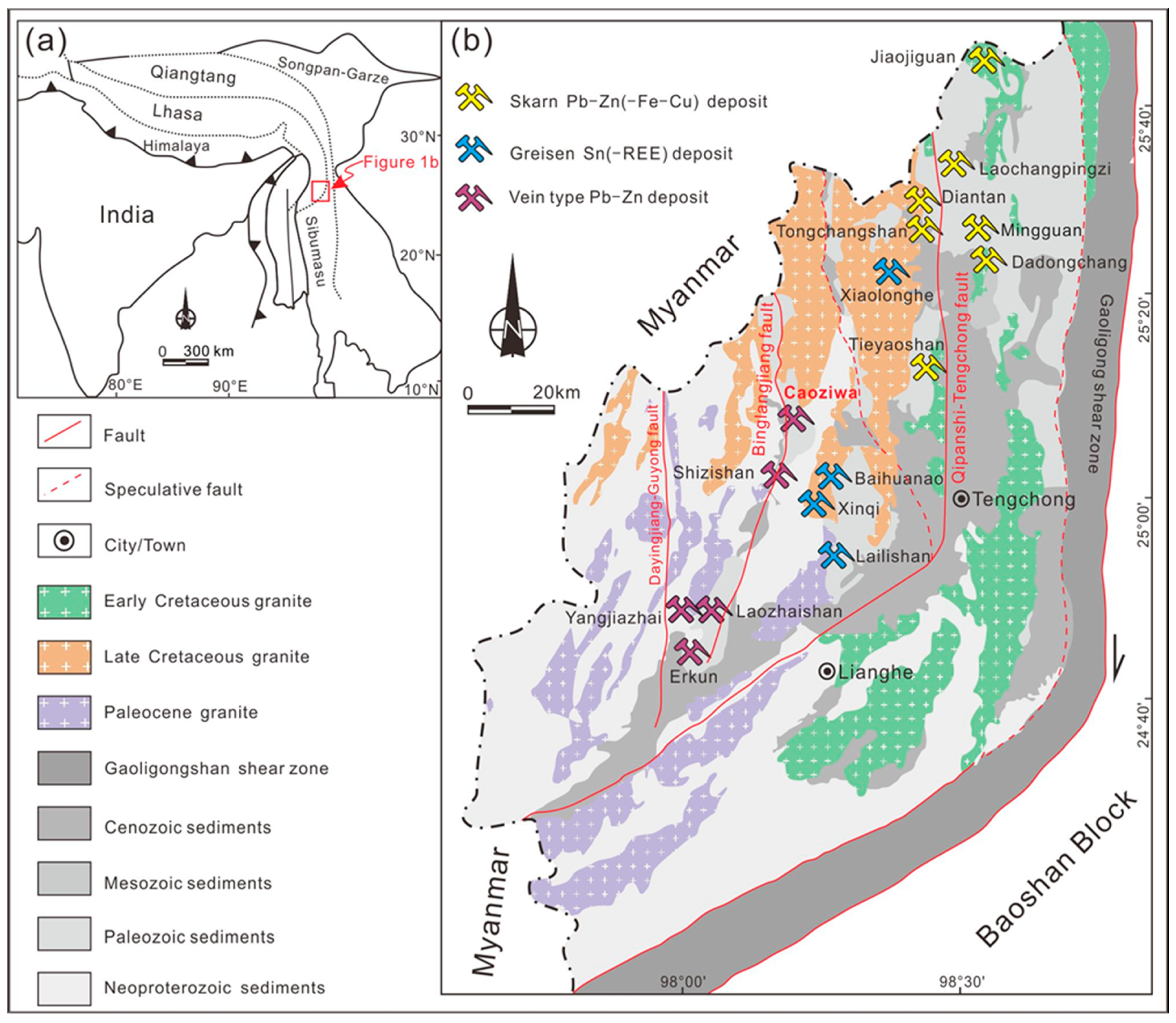
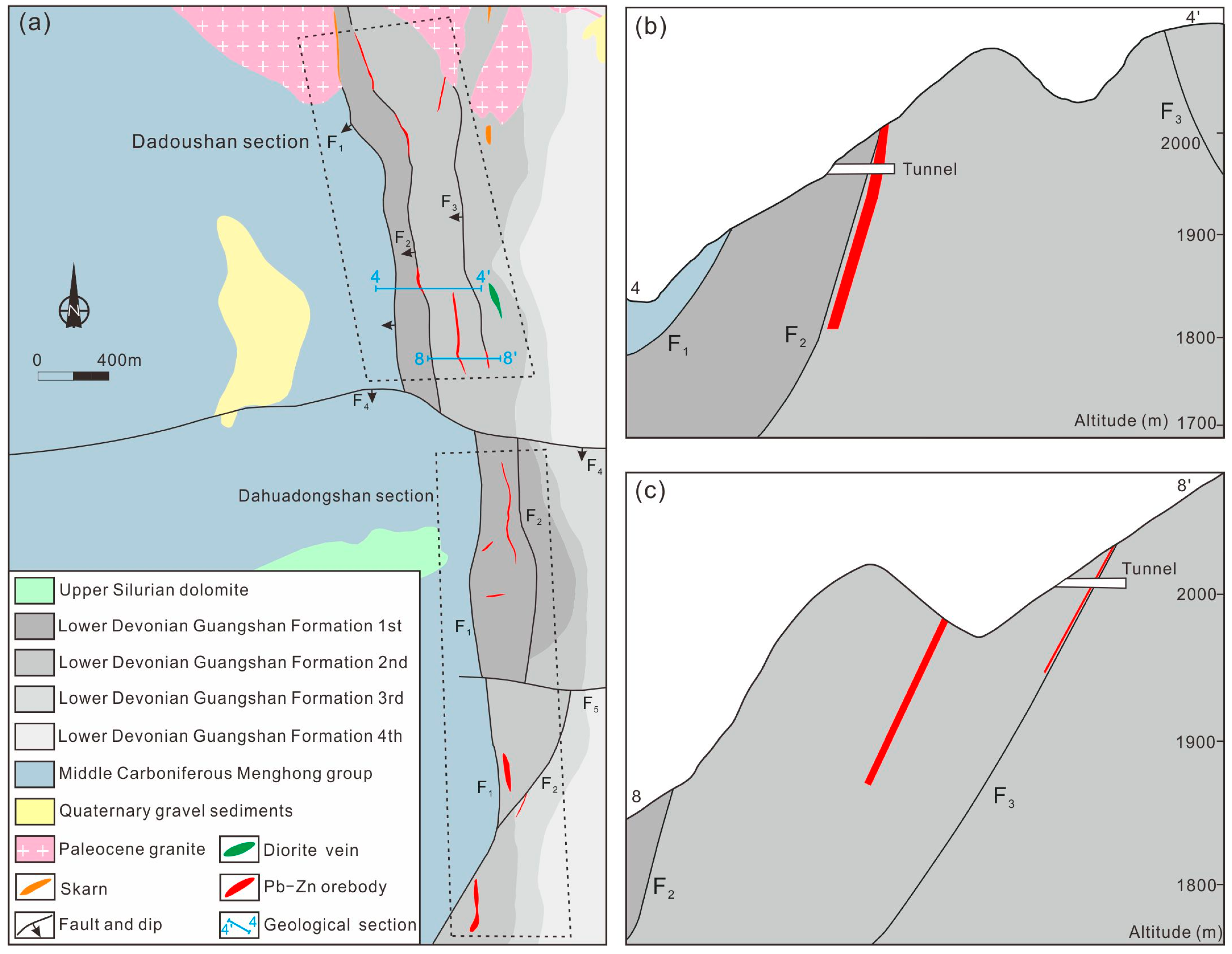
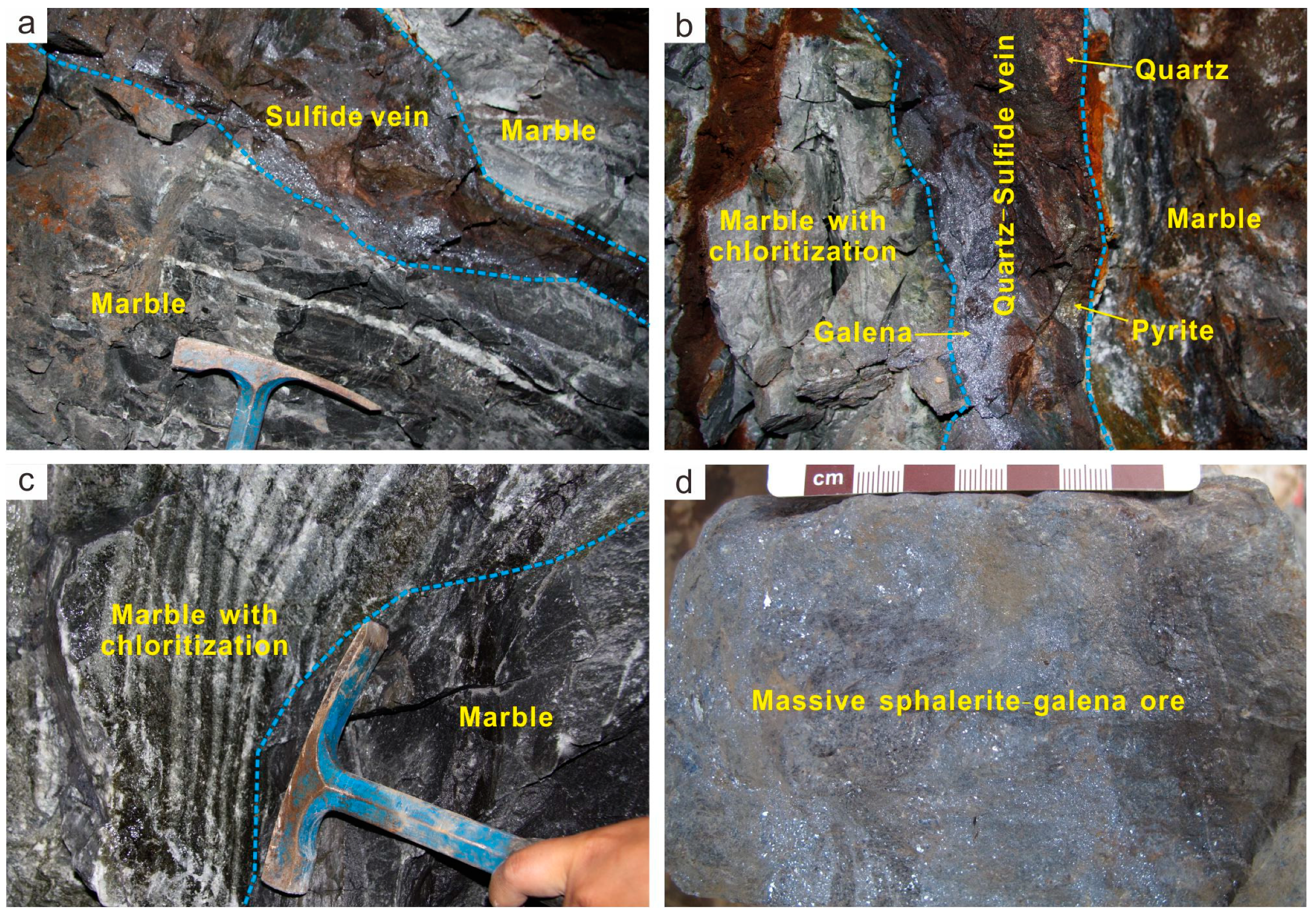
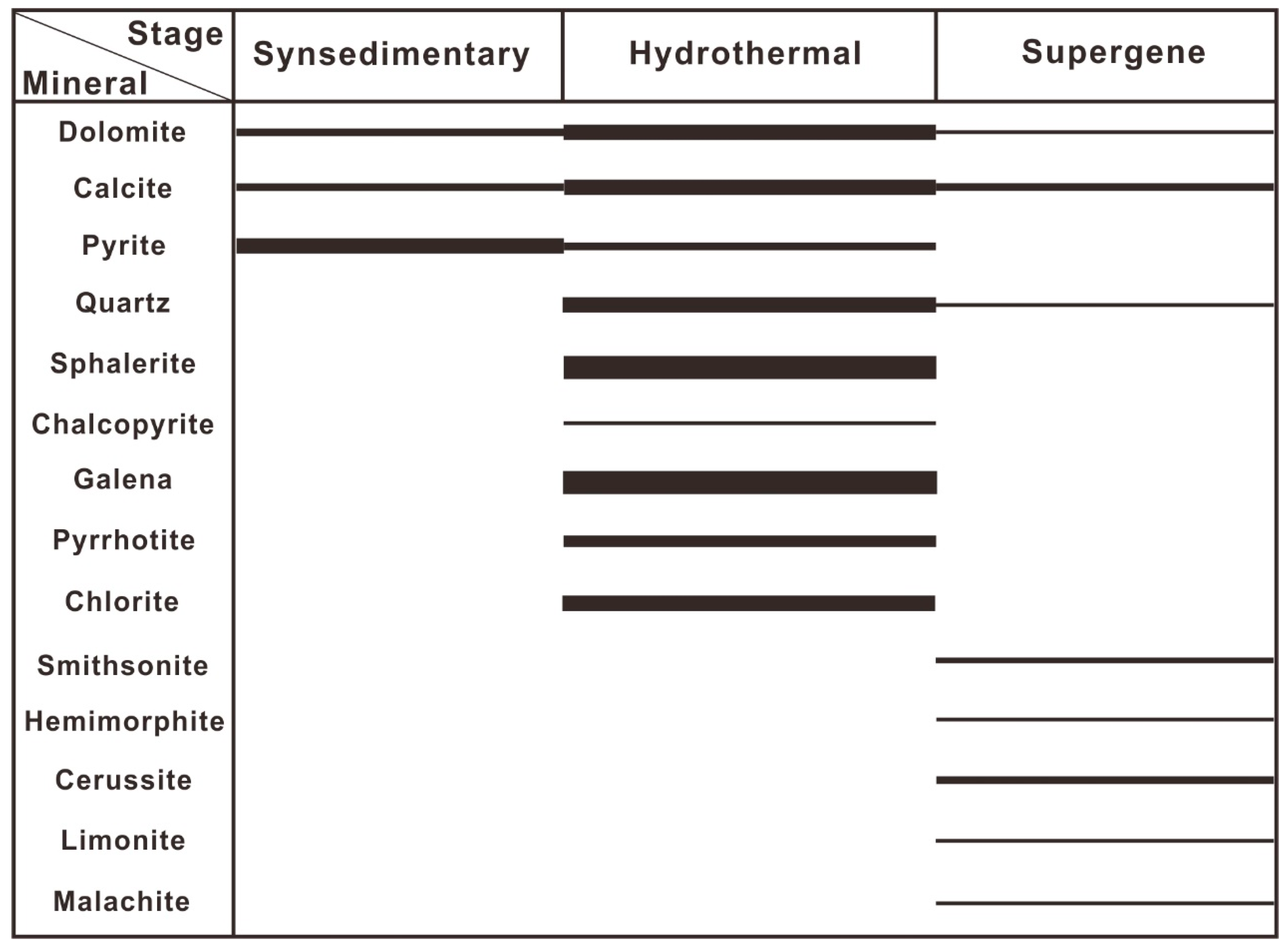
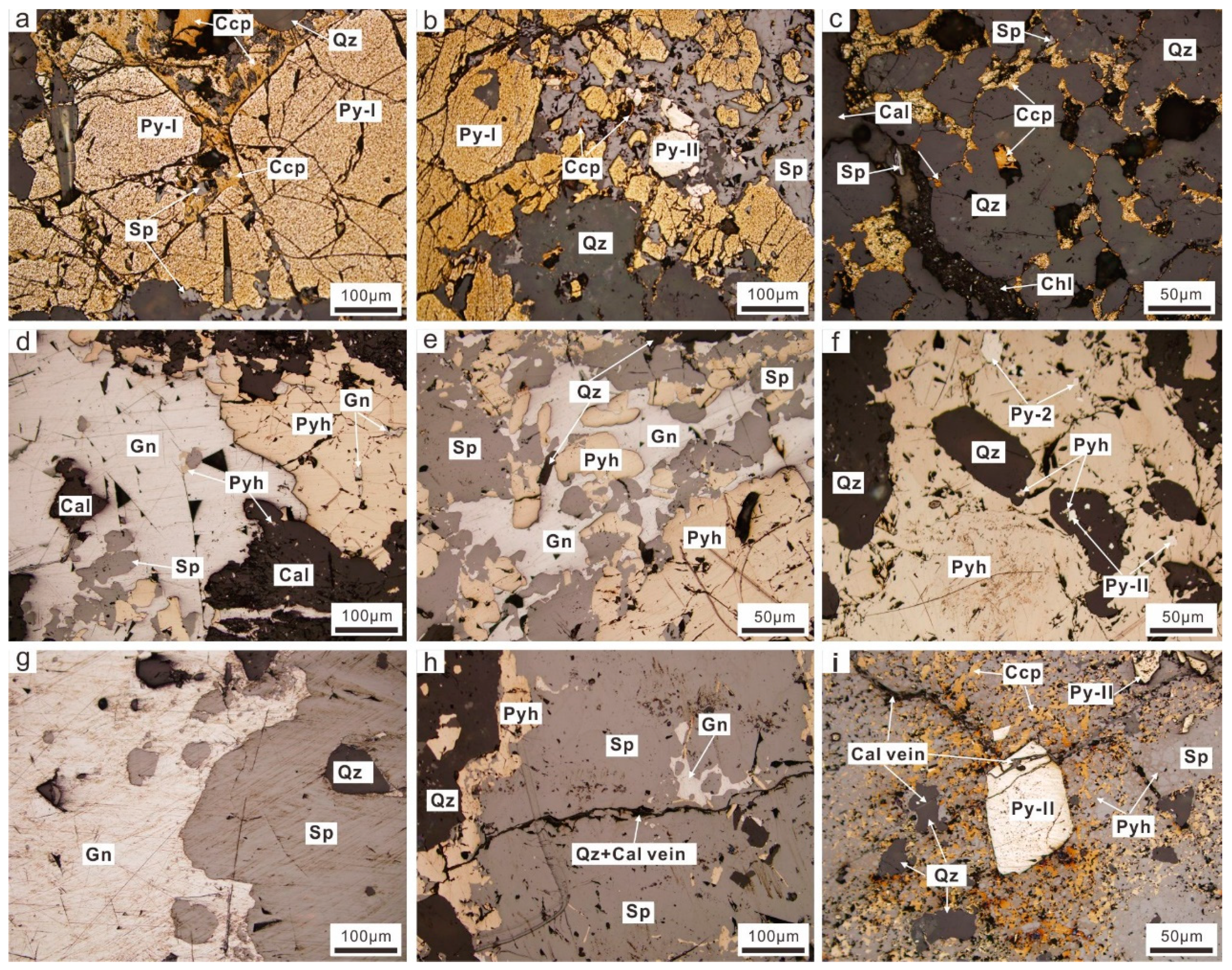
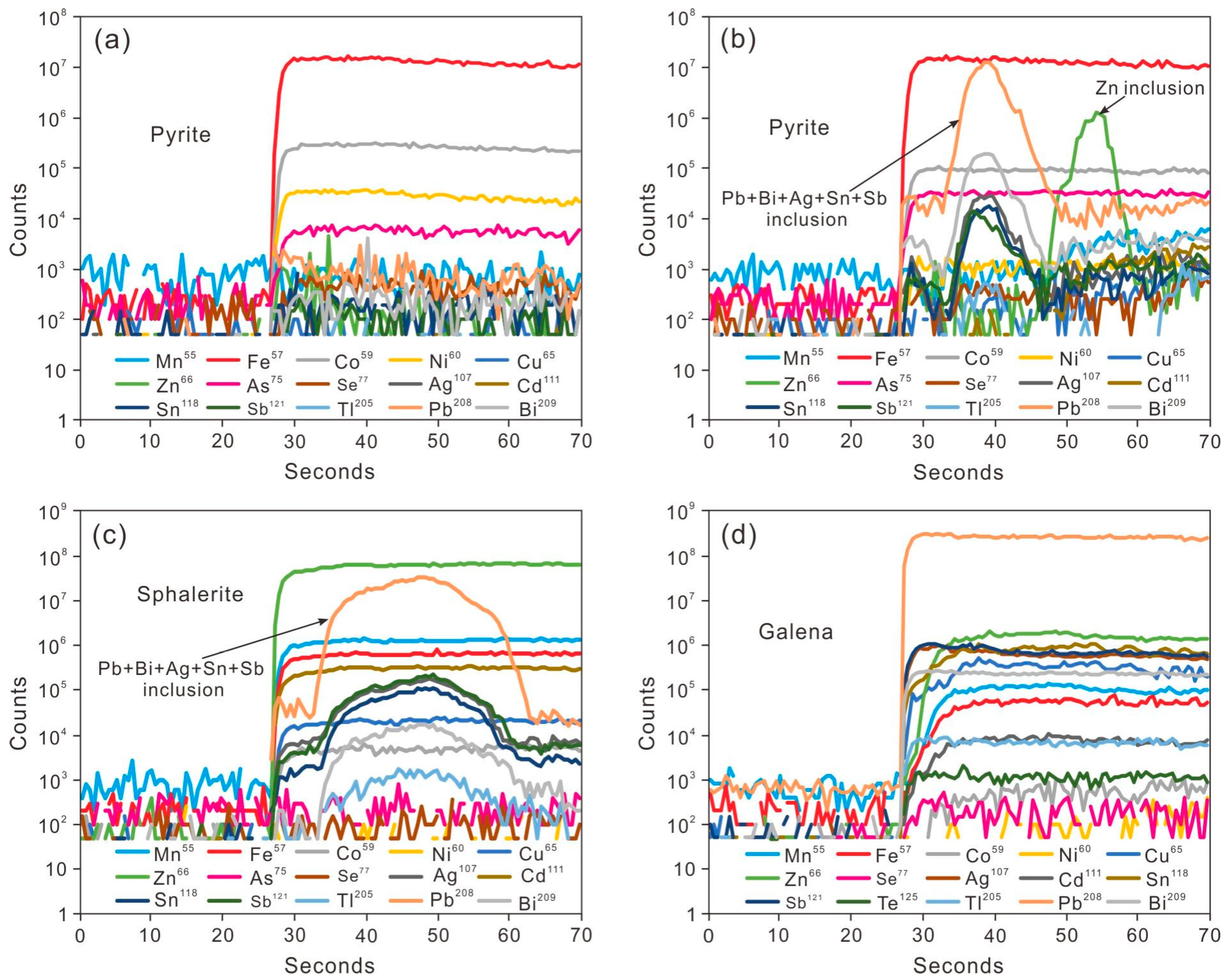

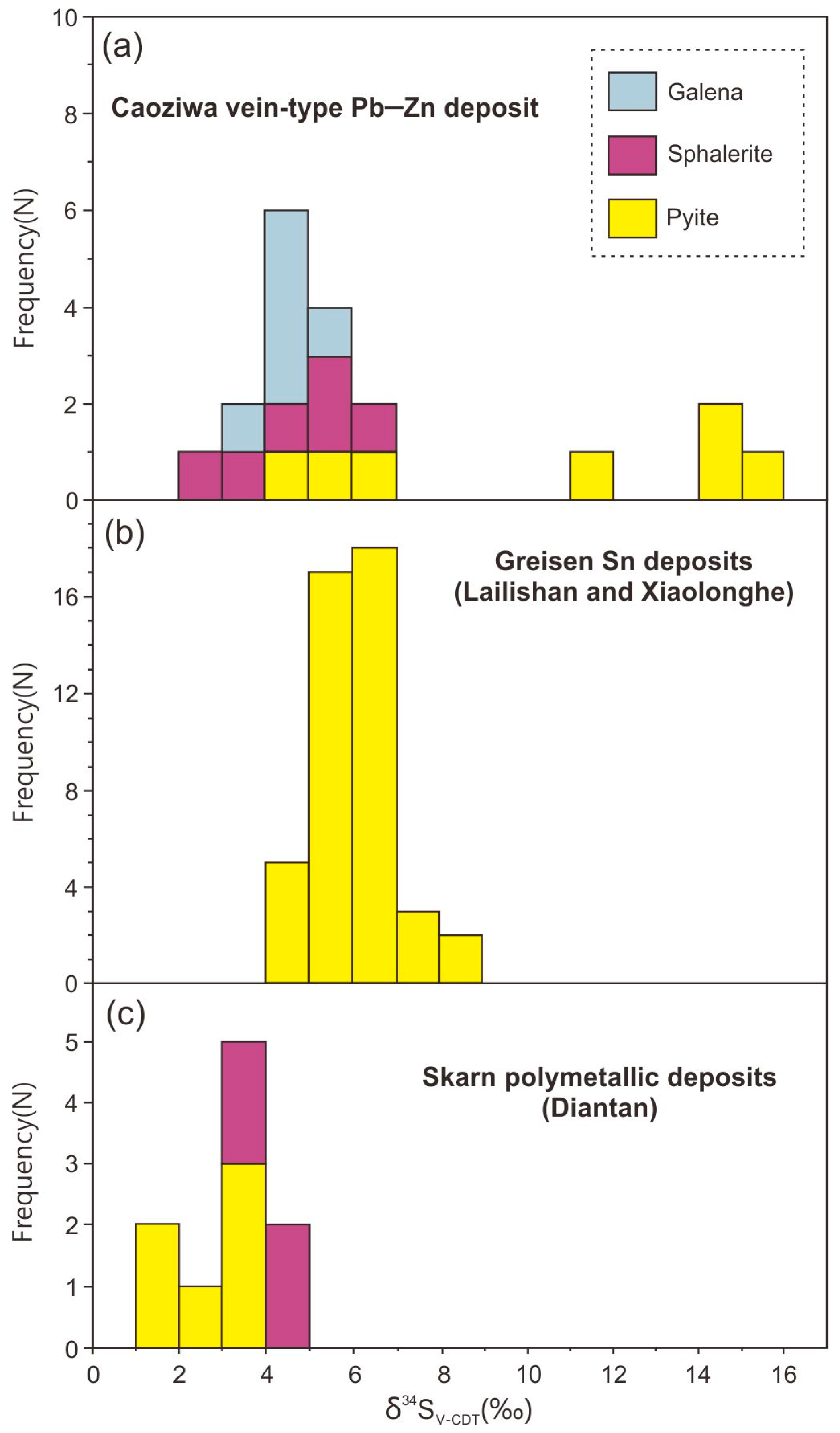
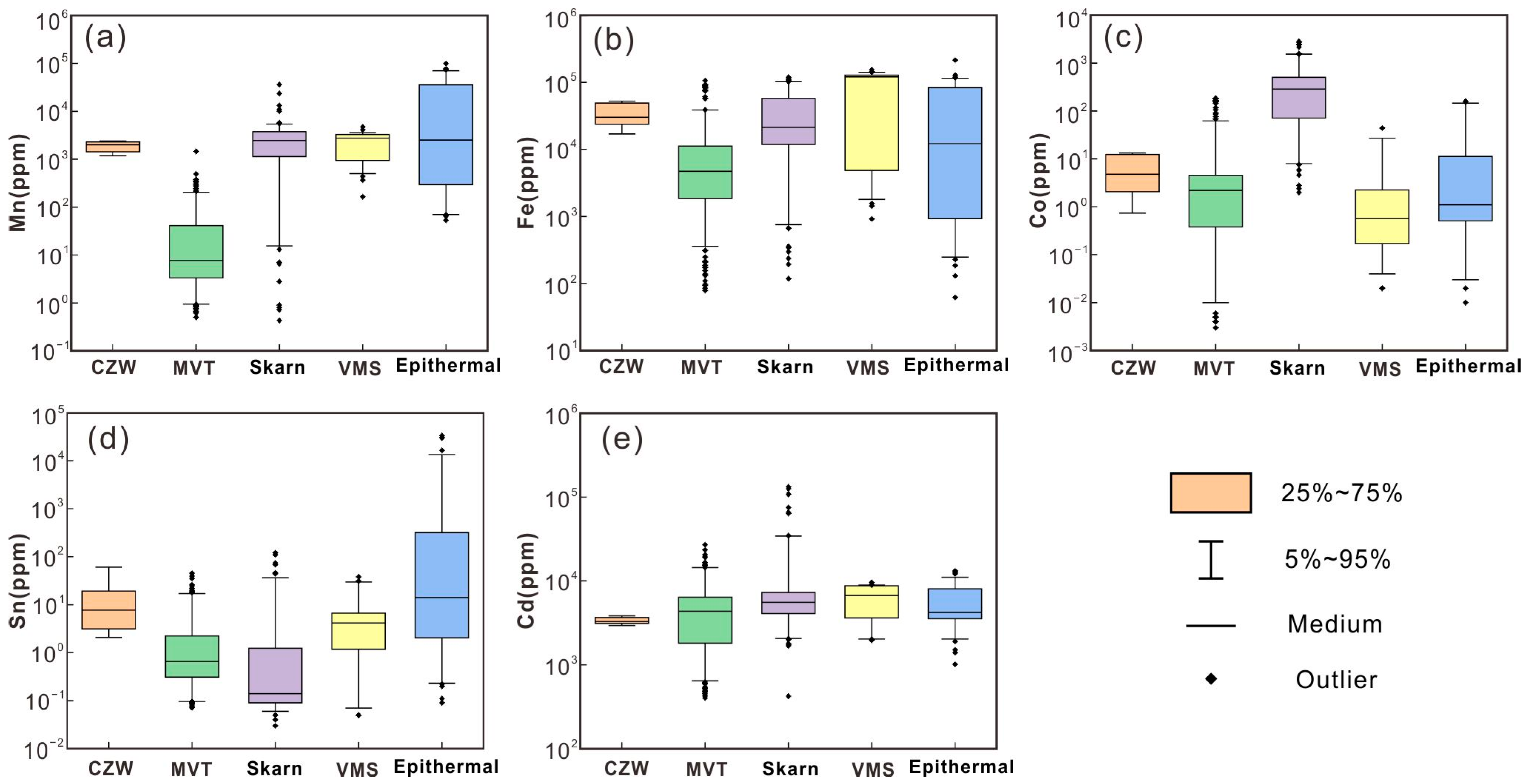
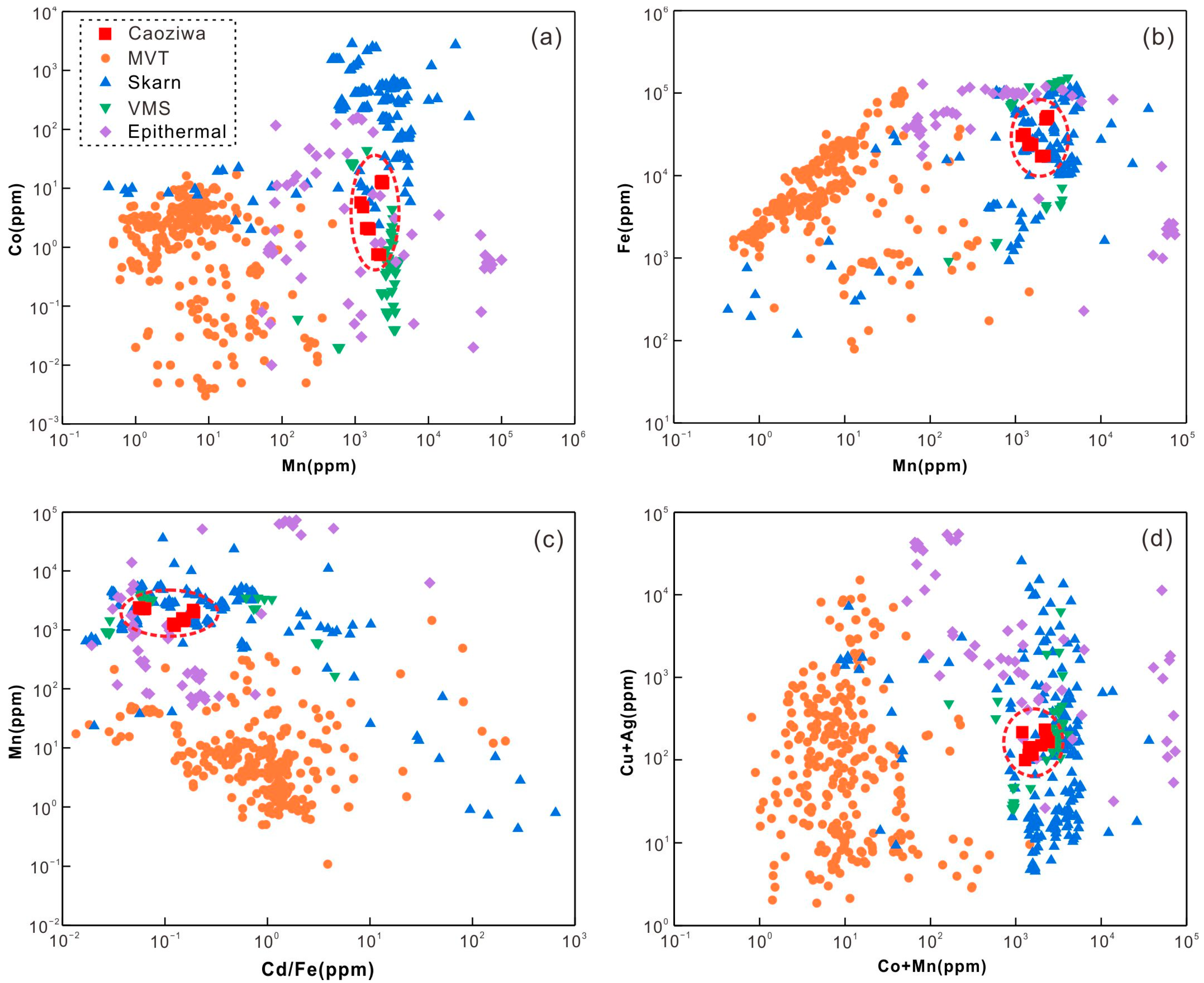

| Stage | Sample No. | Description | Sulfide | δ34S (‰) |
|---|---|---|---|---|
| Syn-sedimentary stage | CZW-01 | Euhedral Py-I in dolomite | Py-I | 15.3 |
| CZW-02 | Euhedral Py-I in marble | Py-I | 14.2 | |
| CZW-03 | Subhedral to euhedral Py-I in marble | Py-I | 14.7 | |
| CZW-05 | Euhedral Py-I in marble | Py-I | 11.5 | |
| Hydrothermal stage | CZW-06 | Massive sulfide ores | Py-II | 6.7 |
| Sphalerite | 6.1 | |||
| Galena | 5.9 | |||
| CZW-09 | Massive sulfide ores | Py-II | 4.5 | |
| Galena | 4.2 | |||
| CZW-10 | Massive sulfide ores | Sphalerite | 3.7 | |
| Galena | 3.1 | |||
| CZW-12 | Massive sulfide ores | Sphalerite | 4.9 | |
| Galena | 4.1 | |||
| CZW-13 | Massive sphalerite ores | Sphalerite | 2.8 | |
| CZW-14 | Massive sulfide ores | Sphalerite | 5.4 | |
| Galena | 4.7 | |||
| CZW-15 | Massive sulfide ores | Py-II | 5.5 | |
| Sphalerite | 5.2 | |||
| Galena | 4.6 |
| Stage | Sample No. | Analysis Spot | Mn | Co | Ni | Cu | Zn | As | Se | Ag | Sn | Sb | Te | Pb | Bi | Co/Ni |
|---|---|---|---|---|---|---|---|---|---|---|---|---|---|---|---|---|
| Syn-sedimentary stage | CZW-01 | 1 | 24.31 | 5.93 | 12.38 | 0.06 | 0.51 | 1123.08 | 1.45 | 0.13 | 0.35 | 1.28 | 0.10 | 1.38 | 0.05 | 0.48 |
| 2 | 102.53 | 23.95 | 35.06 | 0.05 | 0.23 | 853.17 | 3.62 | 0.02 | 0.26 | 0.36 | 0.05 | 3.42 | 0.02 | 0.68 | ||
| 3 | 56.28 | 15.38 | 26.19 | 0.08 | 0.47 | 508.26 | 7.06 | 0.07 | 0.52 | 0.55 | 0.13 | 10.56 | 0.01 | 0.59 | ||
| CZW-03 | 1 | 17.96 | 8.06 | 21.02 | 0.13 | 0.38 | 1038.49 | 5.03 | 0.01 | 0.31 | 0.63 | 0.08 | 4.13 | - | 0.38 | |
| 2 | 46.72 | 12.37 | 18.65 | 0.06 | 0.15 | 807.25 | 5.28 | 0.28 | 0.45 | 0.68 | 0.12 | 3.15 | 0.03 | 0.66 | ||
| average | 49.56 | 13.14 | 22.66 | 0.08 | 0.35 | 866.05 | 4.49 | 0.10 | 0.38 | 0.70 | 0.10 | 4.53 | 0.03 | 0.56 | ||
| Hydrothermal stage | CZW-06 | 1 | 0.15 | 93.39 | 23.16 | 0.03 | 0.80 | 578.32 | 5.25 | 0.05 | 0.13 | 0.02 | 0.04 | 0.41 | 0.02 | 4.03 |
| 2 | - | 70.67 | 9.74 | 0.04 | 0.71 | 5.05 | 8.63 | 0.01 | 0.16 | 0.28 | 0.03 | 0.22 | 0.01 | 7.26 | ||
| 3 | 0.67 | 123.59 | 10.47 | 2.11 | 75.13 | 258.82 | 4.49 | 1.76 | 0.41 | 0.51 | 0.16 | 233.36 | 2.71 | 11.80 | ||
| 4 | 0.03 | 70.34 | 11.55 | 0.12 | 1.88 | 7.86 | 9.03 | 0.25 | 0.17 | 0.21 | 0.08 | 1.03 | 0.18 | 6.09 | ||
| CZW-07 | 1 | 2.02 | 80.37 | 4.98 | 0.88 | 893.03 | 155.58 | 6.26 | 14.32 | 5.66 | 5.46 | 0.92 | 1925.98 | 25.42 | 16.14 | |
| 2 | - | 127.51 | 14.81 | 0.06 | 1.09 | 799.66 | 4.57 | 0.03 | 0.12 | 0.02 | 0.07 | 0.51 | 0.05 | 8.61 | ||
| 3 | 0.25 | 300.85 | 7.81 | 0.06 | 2.93 | 455.28 | 4.37 | 0.01 | 0.14 | 0.13 | 0.10 | 0.44 | 0.02 | 38.52 | ||
| CZW-09 | 1 | 0.08 | 233.10 | 119.67 | 0.01 | 2.71 | 26.76 | 10.93 | 0.11 | 0.16 | 0.11 | 0.13 | 0.94 | 0.09 | 1.95 | |
| 2 | 0.31 | 235.05 | 60.19 | 0.09 | 1.17 | 11.95 | 8.70 | 0.05 | 0.17 | 0.01 | 0.11 | 0.36 | 0.02 | 3.91 | ||
| 3 | 0.52 | 169.63 | 30.63 | 0.49 | 0.63 | 30.92 | 7.86 | 0.19 | 0.22 | 2.51 | 0.34 | 2.97 | 1.48 | 5.54 | ||
| 4 | - | 74.81 | 9.20 | - | 0.46 | 7.69 | 8.44 | 0.22 | 0.15 | 0.01 | 0.09 | 0.12 | 0.01 | 8.13 | ||
| CZW-15 | 1 | 0.06 | 219.63 | 37.41 | 0.05 | 0.75 | 170.17 | 6.26 | 0.01 | 0.17 | - | 0.11 | 0.16 | - | 5.87 | |
| 2 | 0.18 | 148.36 | 69.16 | 0.06 | 1.01 | 36.24 | 11.53 | 0.35 | 0.15 | 0.25 | 0.08 | 0.41 | 0.03 | 2.15 | ||
| 3 | 0.03 | 281.02 | 65.54 | 0.02 | 0.91 | 47.29 | 9.21 | 0.21 | 0.15 | 0.01 | 0.09 | 0.20 | - | 4.29 | ||
| average | 0.39 | 159.17 | 33.88 | 0.31 | 70.23 | 185.11 | 7.54 | 1.26 | 0.57 | 0.73 | 0.17 | 154.79 | 2.50 | 8.88 | ||
| Sample No. | Analysis Spot | Mn | Fe | Co | Cu | Se | Ag | Cd | Sn | Sb | Te | Tl | Pb |
|---|---|---|---|---|---|---|---|---|---|---|---|---|---|
| CZW-06 | 1 | 1406.59 | 24,882.29 | 2.1 | 98.31 | 2.08 | 16.62 | 3661.64 | 6.55 | 11.25 | 0.15 | 0.04 | 549.2 |
| 2 | 1516.71 | 23,740.63 | 2.11 | 104.63 | 1.52 | 34.33 | 3686.11 | 8.99 | 18.93 | 0.18 | 0.04 | 103.69 | |
| 3 | 1429.94 | 23,440.69 | 2.07 | 92.99 | 1.46 | 49.27 | 3569.55 | 8.55 | 4.99 | - | 0.01 | 36.38 | |
| 4 | 1569.93 | 23,899.2 | 2.02 | 91.72 | 1.32 | 24.59 | 3529.78 | 2.91 | 2.92 | 0.1 | 0.01 | 16.94 | |
| CZW-09 | 1 | 1181.83 | 30,266.42 | 5.76 | 83.38 | 1.42 | 133.28 | 3774.55 | 60.58 | 142.57 | 0.89 | 0.39 | 46,978.23 |
| 2 | 1282.31 | 31,925.25 | 4.79 | 87.55 | 1.04 | 11.83 | 3839.88 | 2.48 | 4.52 | 0.01 | 0.01 | 5.84 | |
| CZW-10 | 1 | 2192.58 | 17,375.21 | 0.74 | 105.14 | 1.23 | 126.79 | 3261.22 | 36.14 | 98.97 | 0.35 | 0.32 | 8539.14 |
| 2 | 1997.65 | 17,067.29 | 0.76 | 106.45 | 1.28 | 43.3 | 3287.32 | 7.71 | 18.98 | 0.2 | 0.02 | 20.87 | |
| CZW-12 | 1 | 2305.61 | 49,215.74 | 12.36 | 162.67 | 1.38 | 9.26 | 3143.3 | 3.14 | 5.57 | 0.09 | 0.01 | 2.92 |
| 2 | 2409.85 | 52,692.6 | 12.41 | 158.47 | 0.84 | 4.35 | 2942.11 | 5.2 | 0.61 | 0.05 | - | 1.9 | |
| 3 | 2340.28 | 51,972.76 | 12.12 | 158.73 | 1.64 | 5.16 | 2965.04 | 2.08 | 2.2 | 0.05 | - | 2.06 | |
| 4 | 2319.28 | 49,137.61 | 13.25 | 161.18 | 1.7 | 4.91 | 3122.01 | 19.18 | 0.41 | 0.08 | - | 0.73 | |
| 5 | 2241.9 | 48,018.31 | 12.97 | 172.36 | 1.52 | 12.74 | 2996.27 | 31.7 | 12.37 | 0.07 | 0.03 | 4.18 | |
| Average | 1861.11 | 34,125.69 | 6.42 | 121.81 | 1.42 | 36.65 | 3367.60 | 15.02 | 24.95 | 0.19 | 0.09 | 4327.85 | |
| Sample No. | Analysis Spot | Mn | Fe | Co | Ni | Cu | Zn | As | Se | Ag | Cd | Sn | Sb | Te | Tl | Bi |
|---|---|---|---|---|---|---|---|---|---|---|---|---|---|---|---|---|
| CZW-06 | 1 | 1.48 | 7.71 | 0.02 | 0.17 | 1.16 | 56.62 | 0.07 | 1.07 | 2247.21 | 38.28 | 1074.87 | 2430.48 | 16.50 | 6.53 | 78.86 |
| 2 | 21.93 | 42.75 | 0.02 | 0.10 | 27.67 | 610.69 | 0.06 | 1.37 | 2330.95 | 40.82 | 1151.27 | 2533.65 | 17.62 | 6.86 | 70.44 | |
| 3 | 1.86 | 2.14 | 0.02 | 0.12 | 0.07 | 0.37 | 0.11 | 1.15 | 2306.04 | 44.03 | 1117.27 | 2484.49 | 17.22 | 6.78 | 75.81 | |
| CZW-10 | 1 | 1.73 | 1.17 | 0.02 | 0.23 | 0.01 | 0.27 | 0.02 | 1.15 | 2449.45 | 46.90 | 1391.01 | 2525.53 | 14.93 | 6.84 | 116.73 |
| 2 | 2.34 | 1.52 | 0.02 | 0.19 | 0.08 | 0.31 | - | 1.04 | 2425.76 | 52.65 | 1395.26 | 2537.40 | 15.29 | 6.68 | 113.64 | |
| CZW-12 | 1 | 0.89 | 1.50 | 0.02 | 0.10 | 0.03 | 0.19 | 0.13 | 1.57 | 2300.33 | 38.94 | 1115.49 | 2377.96 | 16.63 | 6.81 | 98.90 |
| 2 | 1.18 | 1.03 | 0.03 | 0.12 | 0.11 | 0.49 | 0.35 | 0.89 | 2172.98 | 43.30 | 1118.99 | 2347.34 | 17.52 | 6.61 | 97.04 | |
| 3 | 1.60 | 7.88 | 0.03 | 0.17 | 0.10 | 1.10 | 0.44 | 1.60 | 2359.82 | 47.44 | 1179.92 | 2422.43 | 15.69 | 6.74 | 95.14 | |
| CZW-15 | 1 | 8.00 | 2289.04 | 0.23 | 0.44 | 26.54 | 1491.33 | 0.11 | 13.19 | 1831.32 | 23.67 | 273.76 | 1815.03 | 57.24 | 6.39 | 249.51 |
| 2 | 121.71 | 3847.24 | 0.77 | 0.50 | 1742.96 | 26,108.08 | 0.13 | 13.41 | 2054.06 | 162.54 | 1589.97 | 2090.94 | 56.38 | 6.35 | 251.66 | |
| 3 | 13.13 | 1068.74 | 0.01 | 0.55 | 5.33 | 7.10 | 0.12 | 23.76 | 2943.08 | 21.44 | 402.38 | 2918.12 | 73.98 | 6.59 | 254.12 | |
| 4 | 15.36 | 371.90 | 0.09 | 0.08 | 280.64 | 2960.02 | 0.28 | 22.42 | 1959.96 | 29.50 | 390.19 | 1946.39 | 66.26 | 5.80 | 260.70 | |
| Average | 15.93 | 636.89 | 0.11 | 0.23 | 173.73 | 2603.05 | 0.17 | 6.89 | 2281.75 | 49.13 | 1016.70 | 2369.15 | 32.11 | 6.58 | 146.88 | |
Disclaimer/Publisher’s Note: The statements, opinions and data contained in all publications are solely those of the individual author(s) and contributor(s) and not of MDPI and/or the editor(s). MDPI and/or the editor(s) disclaim responsibility for any injury to people or property resulting from any ideas, methods, instructions or products referred to in the content. |
© 2024 by the authors. Licensee MDPI, Basel, Switzerland. This article is an open access article distributed under the terms and conditions of the Creative Commons Attribution (CC BY) license (https://creativecommons.org/licenses/by/4.0/).
Share and Cite
Cheng, Y.; Yang, C.; Deng, M.; Bai, F.; Chen, F. Genesis of Caoziwa Pb–Zn Deposit in Tengchong Block, SW China: Constraints from Sulfur Isotopic and Trace Elemental Compositions of Sulfides. Minerals 2024, 14, 82. https://doi.org/10.3390/min14010082
Cheng Y, Yang C, Deng M, Bai F, Chen F. Genesis of Caoziwa Pb–Zn Deposit in Tengchong Block, SW China: Constraints from Sulfur Isotopic and Trace Elemental Compositions of Sulfides. Minerals. 2024; 14(1):82. https://doi.org/10.3390/min14010082
Chicago/Turabian StyleCheng, Yan, Chunhai Yang, Mingguo Deng, Fuxiang Bai, and Fuchuan Chen. 2024. "Genesis of Caoziwa Pb–Zn Deposit in Tengchong Block, SW China: Constraints from Sulfur Isotopic and Trace Elemental Compositions of Sulfides" Minerals 14, no. 1: 82. https://doi.org/10.3390/min14010082
APA StyleCheng, Y., Yang, C., Deng, M., Bai, F., & Chen, F. (2024). Genesis of Caoziwa Pb–Zn Deposit in Tengchong Block, SW China: Constraints from Sulfur Isotopic and Trace Elemental Compositions of Sulfides. Minerals, 14(1), 82. https://doi.org/10.3390/min14010082






